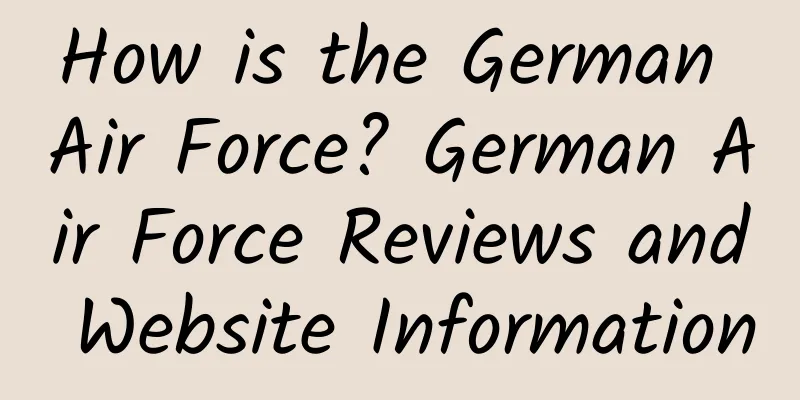How is the German Air Force? German Air Force Reviews and Website Information

|
What is the German Air Force website? The German Federal Armed Forces Air Force (Luftwaffe) is the German air force, established in 1956, with about 28,000 people, and has participated in the Kosovo War and the Afghanistan War. Website: www.luftwaffe.de German Air Force: History, Mission and Modern DevelopmentThe Luftwaffe, as an important part of the German armed forces, has been committed to safeguarding national sovereignty and international peace since its establishment in 1956. As a military department with a long history and advanced technology, the Luftwaffe not only plays a key role in European defense, but also actively participates in peacekeeping operations and humanitarian missions around the world. This article will start from its official website www.luftwaffe.de and explore the history, organizational structure, equipment technology and future strategic direction of the Luftwaffe. The origin and development of the German Air ForceThe history of the German Air Force can be traced back to World War I, when the German Empire established one of the world's earliest independent air forces, the German Imperial Air Force (Deutsche Luftstreitkräfte). However, with the signing of the Treaty of Versailles, Germany was prohibited from having any form of air power. It was not until the Nazi regime came to power that the secretly rebuilt air force gradually became one of the most influential military forces in World War II. After the end of World War II, Germany lost its air force again until the Cold War, when the East-West confrontation intensified and the Western Allies realized the need to rearm West Germany to counter the Soviet threat. In 1956, the German Federal Armed Forces Air Force was officially established, marking the restoration of Germany's legitimate air defense capabilities. Since then, the German Air Force has undergone multiple reorganizations and technological upgrades, gradually growing into a modern, professional force. Expansion and Challenges during the Cold WarIn the early days of the Cold War, the main responsibility of the German Air Force was to protect NATO member states from potential attacks from the Eastern Bloc. To this end, they purchased a large number of American-made fighter jets and other advanced weapon systems and conducted joint training exercises with their allies. Despite limited resources, the German Air Force quickly established its core position in the European air defense system by continuously optimizing tactics and technological innovations. Transformation and Adjustment after UnificationIn the early 1990s, with the fall of the Berlin Wall and the reunification of East and West Germany, the East German People's Army was disbanded and some of its assets were integrated into the Bundeswehr. This change forced the German Air Force to make major adjustments to its size, structure and missions. In order to adapt to the new security environment, the German Air Force reduced its personnel and eliminated some obsolete equipment, while shifting its focus to multinational cooperation and crisis management. Organization and functions of the German Air ForceToday, the German Air Force has about 28,000 active military and civilian personnel, distributed in multiple bases and units. Its main functions include national air defense, intelligence reconnaissance, transportation support, and support for ground forces. In addition, the German Air Force also actively participates in international coalition operations, such as the Kosovo War, the Afghanistan War, and the fight against terrorism in recent years. Operational Command SystemThe Luftwaffe adopted a hierarchical command system, with the highest command directly leading each combat unit. These units are usually divided into the following categories:
International Cooperation and ExchangeAs an important member of NATO, the German Air Force frequently conducts joint training and exercises with other countries' armies. This cross-cultural interaction not only enhances interoperability between each other, but also provides countries with opportunities to learn advanced technologies and development concepts. For example, in the "Euro Typhoon" fighter project, Germany and several other European countries jointly developed a multi-purpose fighter with excellent performance. Technical equipment of the German Air ForceThe German Air Force is known for its highly modern arsenal, which includes a range of the most advanced aircraft models in the world. Here is a brief introduction to some of the key equipment: Main fighter
Transport and refueling machine
Unmanned aerial vehicle systems
The future of the LuftwaffeFaced with an increasingly complex international security situation, the German Air Force is actively planning its future development blueprint, which includes continuing to promote equipment renewal, strengthening network defense capabilities, and deepening cooperation with other countries. New fighter jet programIn order to replace the aging Tornado fleet, the German Air Force launched the Future Combat Air System (FCAS) project. The project aims to develop a next-generation stealth fighter, which is expected to be put into service after 2030. FCAS is not just a single platform, but a comprehensive solution that integrates multiple cutting-edge technologies and systems. Digital transformationWith the rise of emerging technologies such as artificial intelligence and big data analysis, the German Air Force is also working hard to achieve its own digital transformation. By introducing automated decision-making tools and augmented reality training simulators, they hope to improve combat efficiency and reduce operating costs. Sustainable Development GoalsEnvironmental awareness is growing worldwide, and the German Air Force is also concerned about reducing carbon emissions. They are currently studying how to reduce the impact of aircraft on the environment by using biofuels or improving engine design. ConclusionThe German Air Force is not only an important pillar of Germany's national security, but also a key force in maintaining peace and stability in the international community. Through continuous innovation and unremitting efforts, this young force has proved that it can play an important role on the complex and ever-changing world stage. Visit their official website www.luftwaffe.de to learn more about the German Air Force, including the latest developments, recruitment opportunities, and public open days. The Luftwaffe will continue to fulfill its noble mission of defending freedom and justice both at home and abroad. We look forward to seeing this dynamic team achieve even greater success in the future. |
<<: How is the web application company? Web application company reviews and website information
>>: How is Thailand DATC? Thailand DATC review and website information
Recommend
How to prevent cooking oil from going bad
Cooking oil is an essential condiment for every h...
Cowpea balcony planting tips and nutritional value
Sometimes it is also very good to plant cowpeas o...
How to cook bamboo fragrance rice How to steam bamboo fragrance rice
Bamboo rice is a rice ingredient with extremely h...
Watermelon Jelly
I believe everyone is familiar with watermelon je...
What are the side effects of royal jelly? What are the precautions for eating royal jelly?
Royal jelly is a top-grade health product and a n...
Nutritional value and medicinal value of melon seeds
Many people are not very familiar with melon seed...
What are the New England Patriots like? New England Patriots reviews and website information
What is the New England Patriots website? The New ...
How to make Thirteen Treasures Porridge
How much do you know about the recipe of Thirteen...
Scallop Chicken Congee
Scallop chicken porridge is a kind of porridge ma...
The efficacy and function of aloe vera and the taboos of aloe vera
I believe everyone knows aloe vera, which is a ki...
The efficacy and function of Huang Xueguang The key points of planting Huang Xueguang
Huang Xueguang, also known as Xiao Xueguang, is a...
The efficacy and effects of autumn delay
Autumn delay refers to some effects during cultiv...
The efficacy and function of potato mask
Potatoes are a kind of root vegetable that people...
How long is the shelf life of soy sauce?
Oil, salt, sauce and vinegar are usually indispen...
The difference between Arctic shrimp and ice shrimp
The difference between Arctic shrimp and ice shri...









